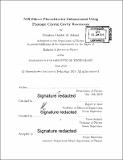NIR silicon photodetector enhancement using photonic crystal cavity resonators
Author(s)
Al Johani, Ebrahim Dakhil.
Download1203144599-MIT.pdf (8.443Mb)
Other Contributors
Massachusetts Institute of Technology. Department of Physics.
Advisor
Rajeev J. Ram and Marin Soljačić.
Terms of use
Metadata
Show full item recordAbstract
The growing demand for efficient infrared sensors for light ranging, thermal-cameras, and soon, free-space optical communications has yet to be answered. In this study, we use polycrystalline silicon in conjunction with a photonic crystal cavity (PhCC) to enhance light absorption for efficient sensing. We present a cost-effective alternative to the current III-V detectors. By adding a 2D-PhC resonator layer, surface-illuminated light can be confined within a 10 micron region with great intensity, leading to a higher effective path-length and improved detector responsivity. More than 1000 variants of this detector are designed and implemented in a 65nm CMOS process. Using a nearest neighbor method, we find the optimized designs. We validate experimental findings by simulating mode behavior of the PhCC structures using FDTD models. In addition, a numerical study on cavity parameter optimization for achieving high Q-factors and extinction ratios specifically for surface-illumination is presented. We report polysilicon PhCC-enhanced sensors with Q-factors of 6500 resulting in responsivities at 1300nm up to 0.13mA/W -a 25x improvement over non-resonant surface-illuminated Silicon detectors.
Description
Thesis: S.B., Massachusetts Institute of Technology, Department of Physics, 2019 Cataloged from PDF of thesis. "The Table of Contents does not accurately represent the page numbering"--Disclaimer page. Includes bibliographical references (pages 45-47).
Date issued
2019Department
Massachusetts Institute of Technology. Department of PhysicsPublisher
Massachusetts Institute of Technology
Keywords
Physics.